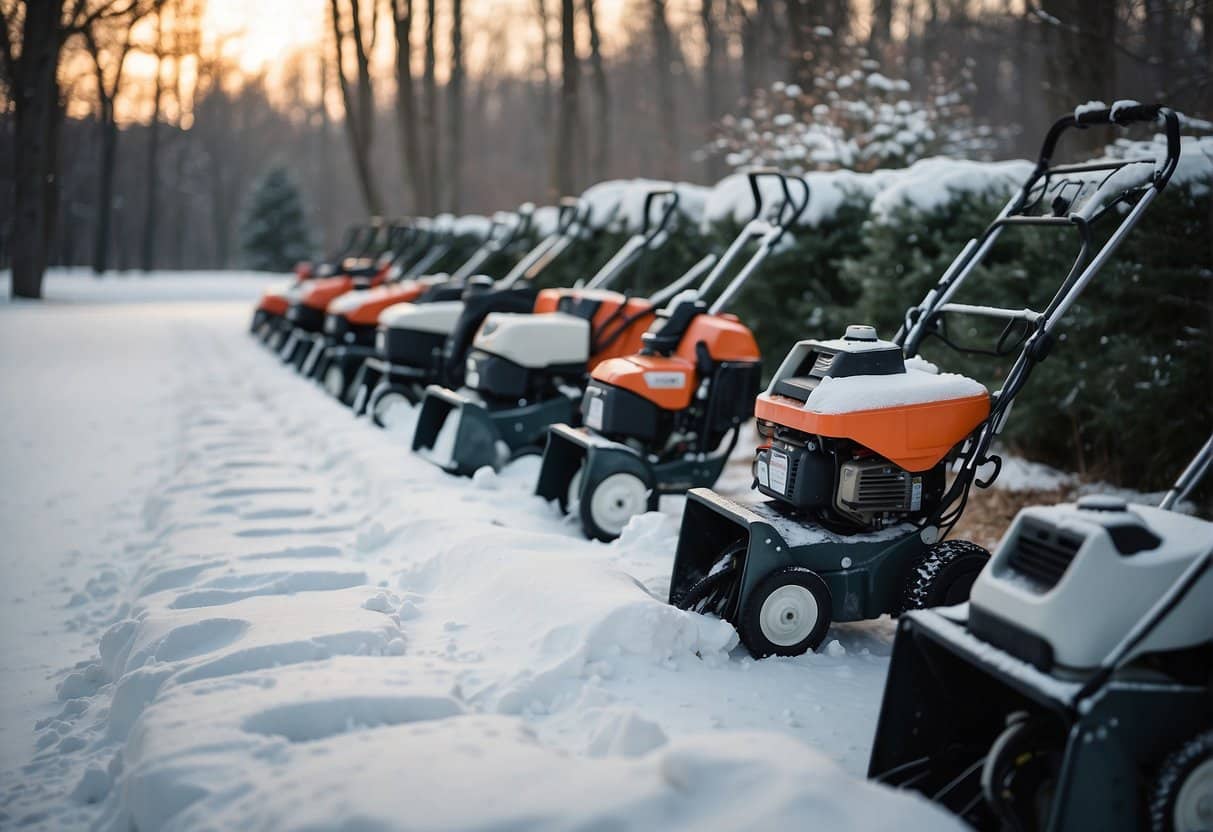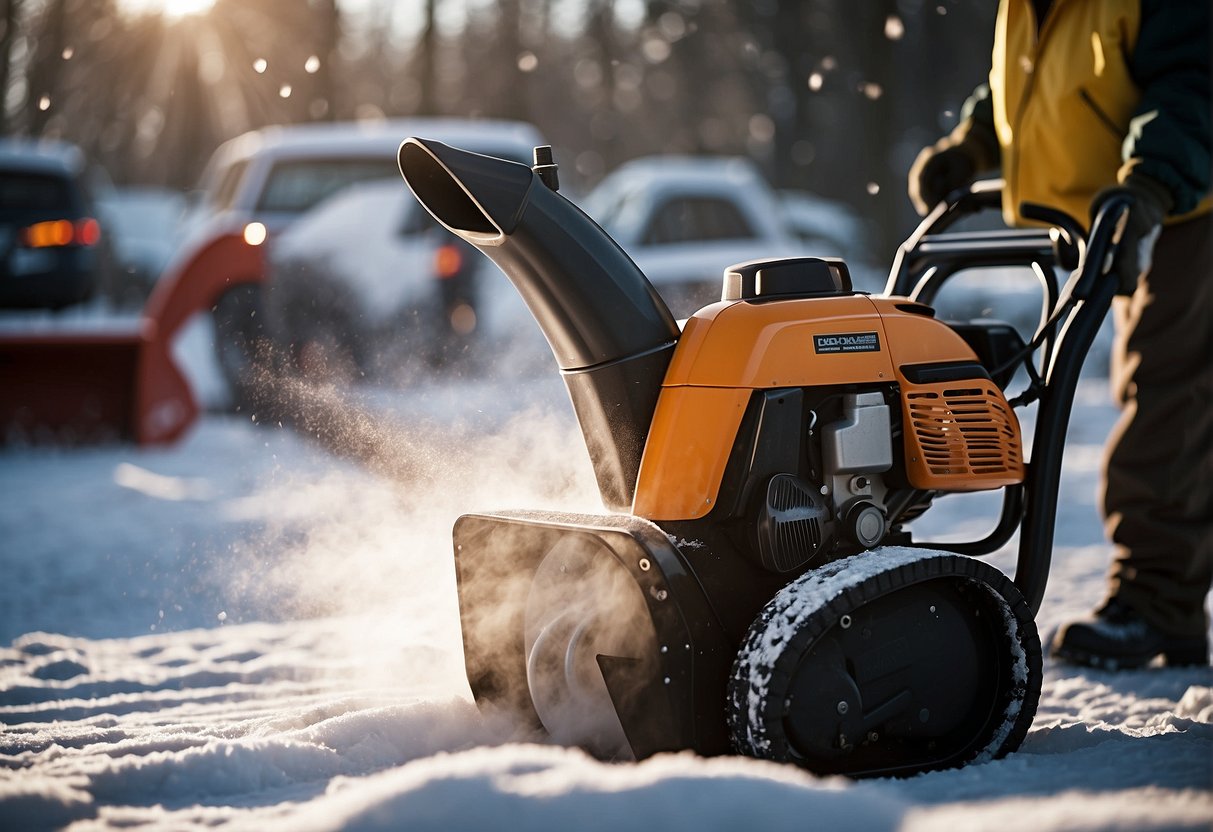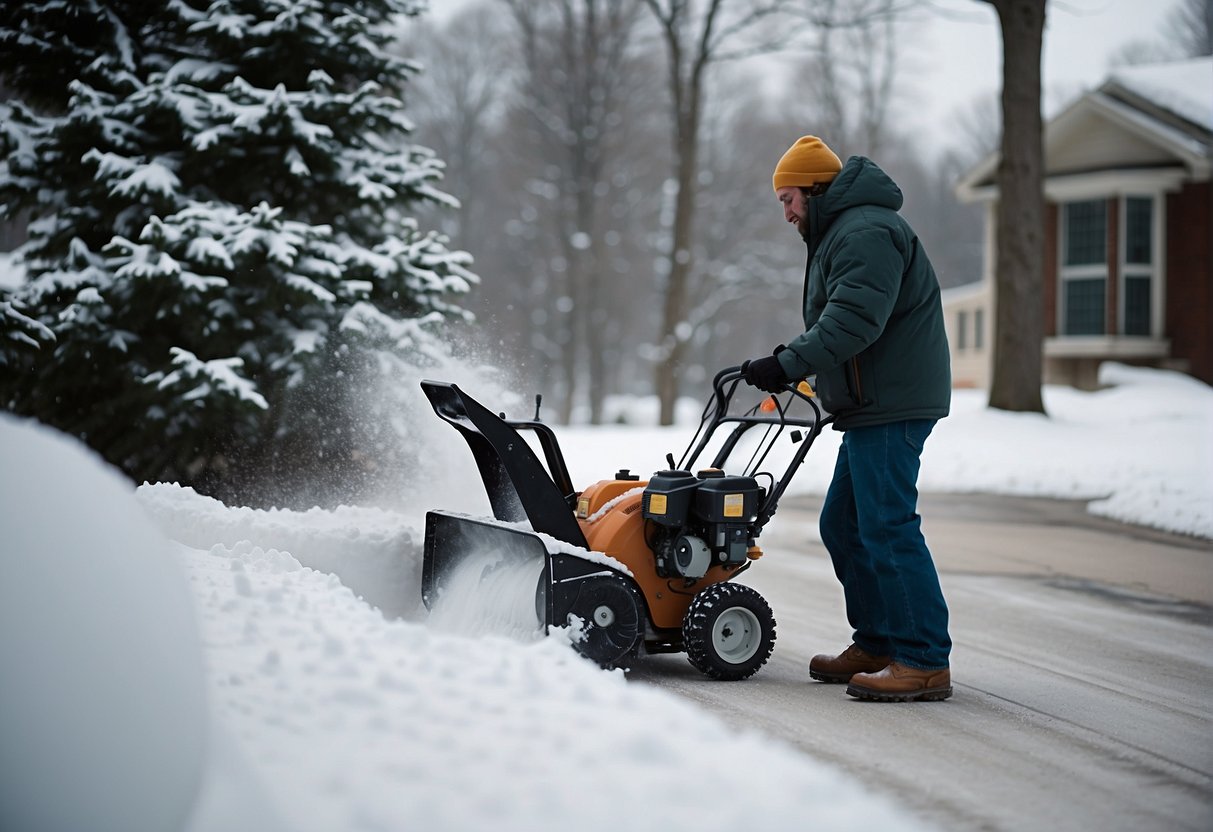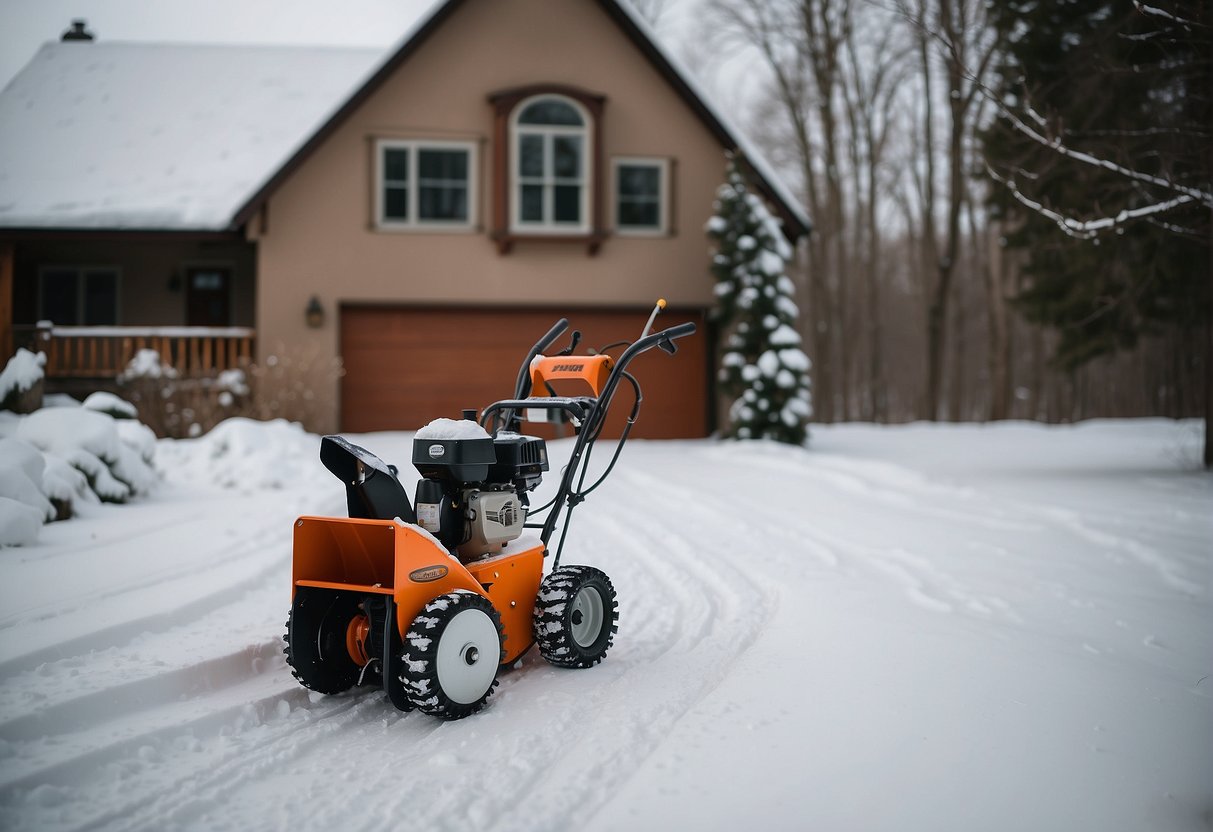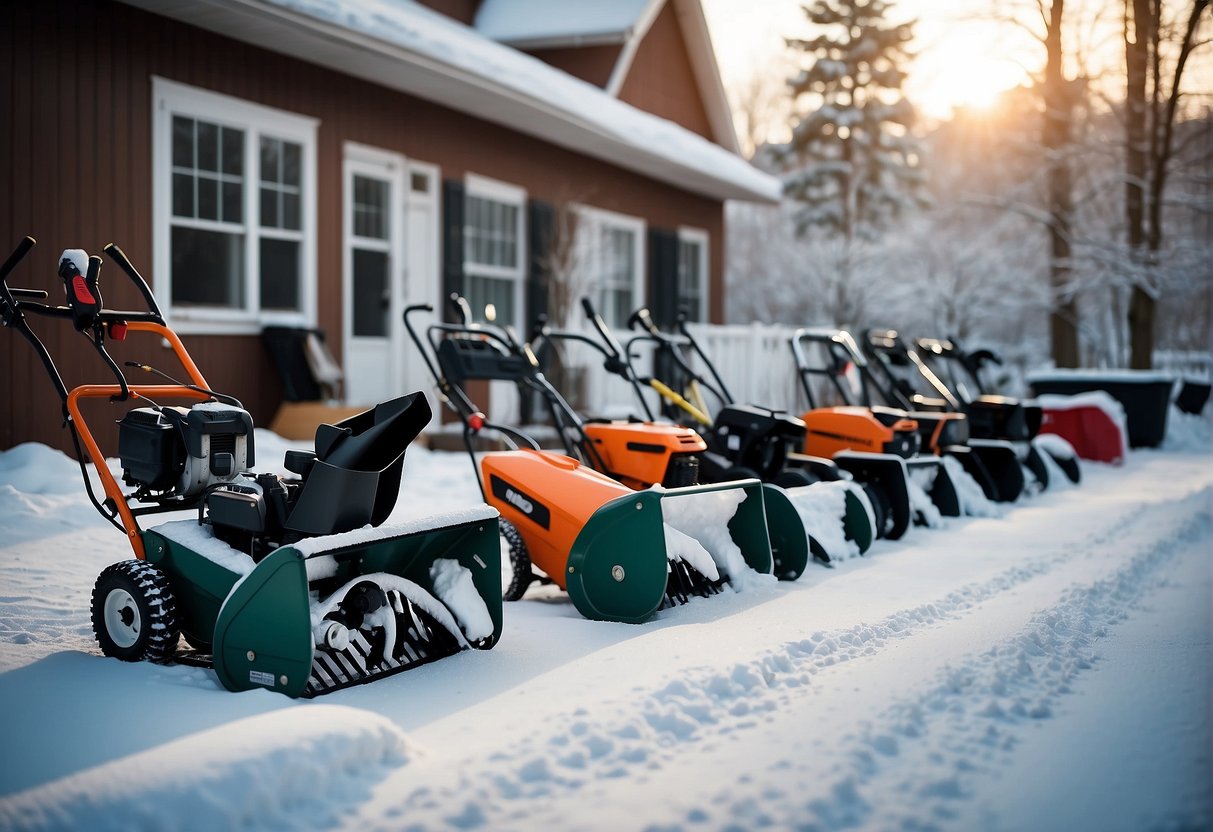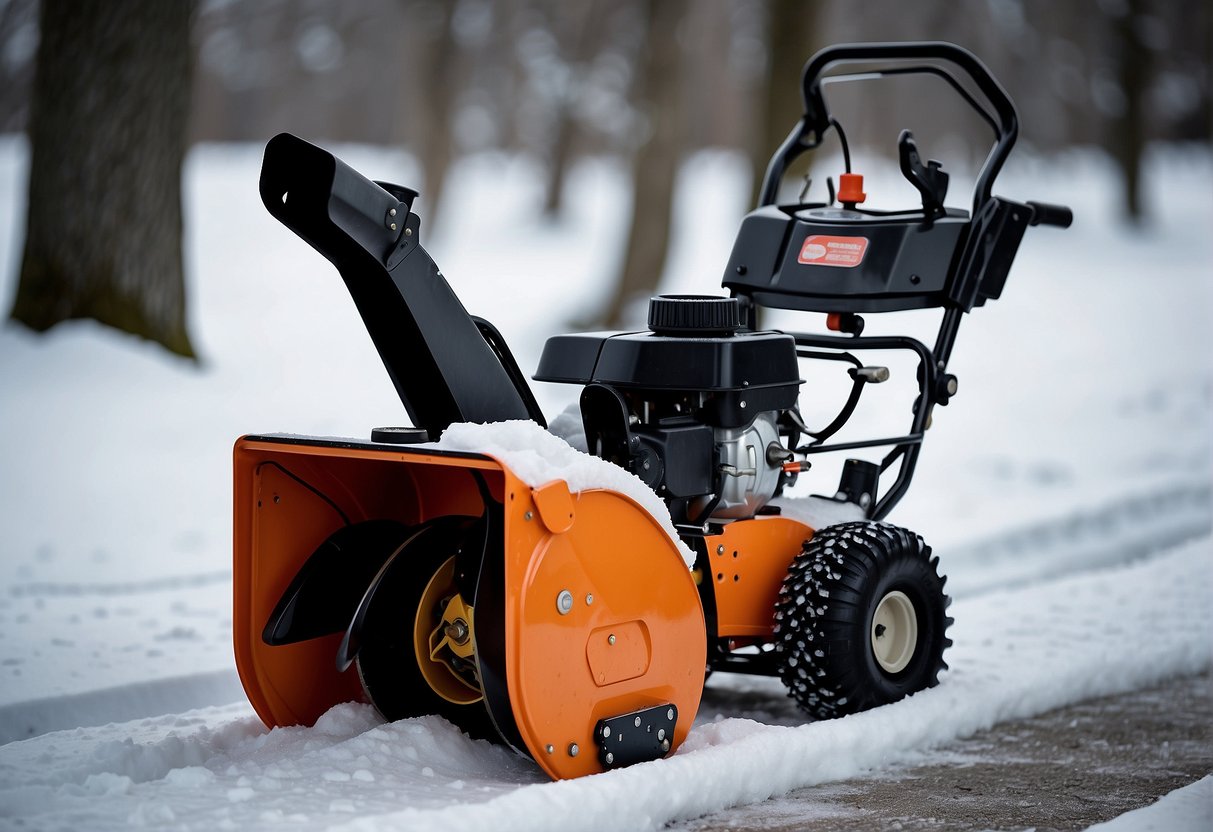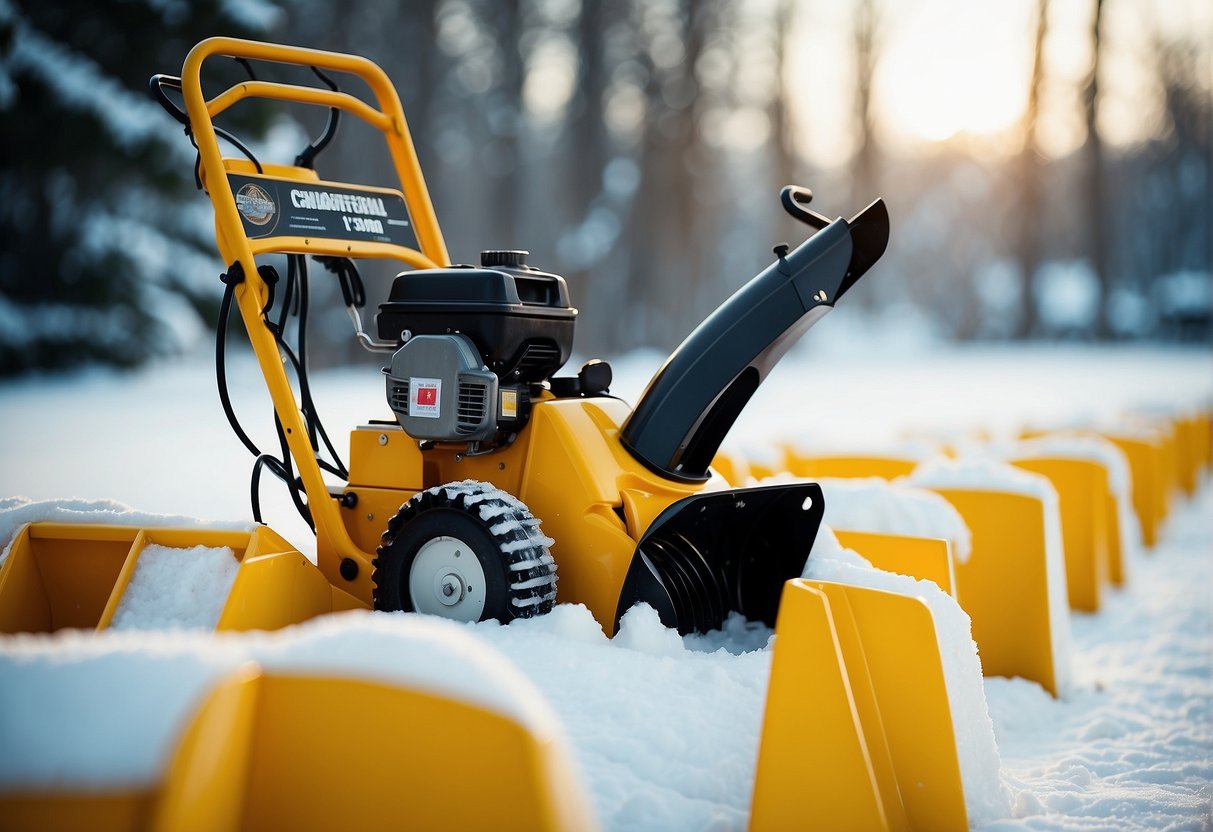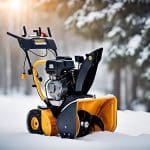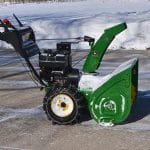Selecting the right snow blower is essential for effective snow removal. With the variety of models available, it is important to understand the differences and determine which type best suits individual needs. The process involves more than just choosing the most powerful option; it requires considering the specific features that will make snow clearing easier, safer, and more efficient for the user’s particular circumstances.
When embarking on the quest for the ideal snow blower, prospective buyers should consider a range of factors. These include the size of the area to be cleared, the usual snowfall amount and density, as well as storage space and budget. Additionally, the power source significantly affects the operation, as snow blowers come in electric, battery-powered, and gas options, each with its own set of advantages and implications for maintenance and performance.
Key Takeaways
- The right snow blower matches the user’s specific snow removal needs and environmental conditions.
- Important considerations include the machine’s features, power source, and the user’s budget.
- Safety, reliability, and ease of use are critical for a satisfactory snow blower purchasing decision.
Understanding Snow Blower Types
Choosing the right snow blower requires knowledge of the different types available. Each type varies in terms of power, size, and features, suitable for different snow clearing needs.
Single-Stage Snow Blowers
Single-stage snow blowers are suited for lighter snowfall conditions, typically up to 8 inches of snow. They use a single high-speed auger to scoop up the snow and throw it out of the chute in one motion. These models are lightweight and easier to maneuver, making them ideal for small driveways and sidewalks. Features to consider in single-stage blowers include auger material, usually rubber-tipped to prevent surface damage, and engine type, which can be electric or gas.
Two-Stage Snow Blowers
Two-stage snow blowers provide more power by employing a two-step process. First, a metal auger breaks up the snow; then, an impeller throws the snow out through the chute. This system enables them to handle heavier snowfalls, up to 18 inches. They often include features such as skid shoes for height adjustment and driven wheels for better traction. Their engines are larger, and most models are gas-powered. They are well-suited for clearing large driveways and areas with wet, heavy snow.
Three-Stage Snow Blowers
For the heaviest and toughest snow clearing jobs, three-stage snow blowers excel. They incorporate an additional auger, called an accelerator, which chops up the snow before it reaches the impeller, allowing for even faster clearing. They can tackle over 18 inches of snow, including the dense, icy piles left by snow plows. Key features of three-stage blowers include larger engines, heated grips, and power steering for enhanced control and comfort. This type is typically the most expensive due to its power and advanced features.
Factors to Consider When Choosing a Snow Blower
Selecting the right snow blower involves evaluating the typical snowfall in your area and the specific features of your property. It’s essential to determine the appropriate size and power source to effectively clear snow.
Assessing Your Snowfall and Terrain
- Snowfall: The amount and type of snowfall you get will greatly influence your choice of snow blower. For light snowfalls of a few inches, a single-stage electric blower may suffice. However, areas with heavy snowfall will require a two-stage or even three-stage gas-powered machine capable of handling snow depths of over 8 inches.
- Terrain: The type of terrain you’ll be clearing is another crucial consideration. Flat surfaces can be easily managed with most snow blowers, but uneven terrain with slopes may need a snow blower with large tires and good traction. If your surface is gravel or uneven, a two-stage model is better as it doesn’t touch the ground, thus minimizing the risk of picking up and throwing rocks.
Determining the Right Size and Power Source
- Size: Your snow blower should be proportional to the area you need to clear. Small pathways and driveways might only need a compact model, while larger spaces could benefit from a wider clearing width.
- Power Source: Snow blowers are generally available in three types: battery-powered, electric (corded), and gas-powered. Each has its advantages and limitations.
- Battery: Battery-powered blowers offer the convenience of cordless operation and are quieter than gas models. They’re most effective for short sessions since battery life is limited.
- Electric (Corded): These are lightweight and start instantly, typically with a push button. However, their range is restricted by the length of the extension cord.
- Gas: Gas-powered blowers are more powerful and suitable for longer, uninterrupted clearing sessions, offering more mobility than corded models. Look for models with an electric start to avoid the need for manual pull-starting in cold weather.
Key Features to Look For
When selecting a snow blower, it is crucial to focus on performance and ease of use. Consumers should assess certain features that significantly impact the machine’s efficiency in snow removal tasks.
Auger and Impeller Mechanisms
The auger is the tool’s crucial part responsible for collecting snow, and it can be fashioned from metal or durable plastic. Metal augers tend to offer longevity and reliability, especially in tough, icy conditions. The impeller, often located behind the auger, propels the snow out of the chute. A robust auger and impeller combination is vital for moving heavy snow efficiently. Typically, a larger impeller equates to better snow-throwing capabilities.
- Metal Auger: Durable, reliable for icy conditions.
- Impeller Size: Larger size, greater snow-throwing capabilities.
Chute Control and Throwing Distance
Chute control is central to directing where the snow is dispensed. Mechanisms to adjust the chute range from manual to joystick or lever controls found in advanced models, facilitating ease of direction change while operating. The throwing distance refers to how far the snow is ejected from the chute, which varies by model. A longer throwing distance minimizes the frequency of adjusting the chute’s direction, increasing efficiency.
- Manual/Automatic Chute Control: Determines ease of direction adjustment.
- Throwing Distance: Longer distance, less directional adjustment needed.
Starting and Operating Modes
The starting mechanism of a snow blower can be electric or pull-start, with electric models often being more convenient. Operating modes, like speed settings and the inclusion of reverse, can greatly affect maneuverability and the ability to tackle different snow conditions. The clearing width is another essential feature; wider clearing widths reduce the number of passes needed but may affect maneuverability in tight spaces.
- Electric Start: Convenient, typically easier to activate in cold weather.
- Operating Modes: Speed and reverse options for different conditions.
- Clearing Width: Wider widths cut down on clearing time but consider storage and maneuverability.
Evaluating Performance and Efficiency
When choosing the right snow blower, one must consider how well it performs in snow removal tasks and how efficiently it manages different snow conditions. Performance is influenced by the machine’s ability to tackle snow with ease, while efficiency indicates how much effort the user must exert.
Traction and Maneurverability
A snow blower’s traction is critical for stable movement across icy surfaces. Models with larger, deep-tread tires or track drives offer superior traction. These snow blowers maintain grip even on slopes and uneven terrain. Enhanced maneuverability largely depends on features like power steering and an adjustable chute. Power steering enables smoother turns, reducing user fatigue, especially in heavy-duty machines. The chute’s adjustability allows for precise control of snow discharge direction and distance, facilitating efficient clearing paths.
- Traction: Good traction prevents slipping and ensures consistent performance.
- Maneuverability: Look for power steering and easy chute controls for best maneuverability.
Snow Blower Speeds and Controls
The presence of variable speed settings in a snow blower is vital for both performance and efficiency. Snow blowers equipped with multiple forward and reverse speeds allow the user to match the pace of work to the snow conditions. In situations with deep or heavy snow, slower speeds are essential to maintain efficiency without overloading the machine’s engine.
Speeds and Controls:
- Forward Speeds: At least 4-6 for flexibility in different snow densities.
- Reverse Speeds: 1-2 to allow for easy backing out when needed.
- Control Accessibility: Simple and within reach for smooth operation.
It’s important to feel confident in handling a snow blower, as difficult controls can hinder performance. Controls that are ergonomic and straightforward contribute to the overall efficiency and satisfaction in snow clearing tasks.
Power Source Options
When selecting a snow blower, power source is a critical factor that affects performance, convenience, and maintenance. This choice impacts how the snow blower operates in various snow conditions.
Gas-Powered Snow Blowers
Gas-powered snow blowers are potent machines, capable of tackling heavy snowfall and larger areas. They offer mobility since they don’t require a power cord and are available in single, two-stage, or three-stage models. However, they necessitate regular engine maintenance and have a fuel tank that needs to be filled with gas. A notable consideration for these snow blowers is their engine’s starting mechanism, which can be manual pull-start or equipped with an electric start.
- Pros:
- Strong performance in heavy snow
- No power cord restrictions
- Cons:
- Requires more maintenance
- Needs fuel
Electric and Battery-Powered Snow Blowers
Electric snow blowers require a power outlet and are limited by the length of their cord, which may restrict their range. They’re lighter and quieter than gas models and typically need less maintenance. They start up quickly and are well-suited for smaller driveways or walkways with lighter snowfall.
Battery-powered, or cordless, snow blowers provide similar benefits to electric models but offer greater mobility as they aren’t tethered by a cord. These models run on rechargeable batteries and are an excellent option for those seeking an environmentally friendly solution without sacrificing convenience. Battery life and power can vary, and one should consider additional battery packs for larger jobs.
- Pros:
- Quiet operation
- Lower maintenance
- Cons:
- Limited by battery life or cord length
- Generally less powerful than gas models
Convenience and Ease of Use
Choosing the right snow blower involves considering how easy it is to operate and maintain. These aspects directly impact the user’s experience and efficiency when clearing snow.
Starting Systems and Maintenance
Electric Start: For those seeking simplicity, snow blowers with electric start systems are ideal. With the push of a button, the machine powers on, eliminating the physical exertion of pull-cord starters. Maintenance is also a consideration; models with fewer parts, such as electric or battery-powered blowers, typically require less upkeep.
| Maintenance Aspect | Consideration |
|---|---|
| Engine Type | Gas engines may need more frequent maintenance than electric or battery-powered models |
| Oil Changes | Some models feature easy access to oil ports for straightforward changes |
Handling and Mobility Features
Self-Propelled: Users looking for ease of mobility should consider self-propelled snow blowers. They come with various speeds and require less effort to push through snow. Maneuverability is enhanced with features like power steering, which allow for easier turns.
- Headlights: Useful for increasing visibility in early morning or late evening.
- Tracks vs. Wheels:
- Tracks provide better traction on steep or uneven terrain but can be more challenging to turn.
- Wheels offer good maneuverability on flat surfaces and are often easier to handle.
It’s important for potential buyers to physically handle the snow blower if possible, to assess whether its weight and balance align with their strength and needs.
Safety and Reliability
When selecting a snow blower, the consumer’s well-being and the machine’s consistent performance are paramount. It is important to consider the safety measures implemented and the track record of the snow blower’s durability.
Safety Features
- Operator Presence Control (OPC): Ensures the machine will stop moving and the auger will cease to rotate when the user releases the controls.
- Discharge Chute Control: Allows for safe direction of the ejected snow away from the operator and bystanders.
Details of specific safety elements to consider:
| Safety Element | Description |
|---|---|
| Dead Man’s Switch | Prevents the blower from operating if the user is not actively engaged. |
| Clearing Tool | Allows the user to safely remove snow and debris without direct hand contact with the auger. |
| Hand Warmers | Reduces the risk of frostbite for operators in extremely cold conditions. |
Customer reviews and ratings often provide insights into the real-world effectiveness of these safety features.
Durability and Brand Reputation
The longevity and reliability of a snow blower are influenced by:
- Construction Quality: Materials like thick plastic or metal augers and chutes are indicators of durability.
- Engine Quality: A well-built engine from a reputable brand suggests a longer lifespan and fewer malfunctions.
Brand Reputation:
- A history of positive customer feedback can signal that a brand prioritizes safety and durability.
Ratings:
- Consumers should look for high average ratings, especially those that specifically discuss the long-term performance of the snow blowers.
It is advised to rely on recognized brands that demonstrate commitment to longevity and have a history of positive, verifiable third-party customer reviews.
Design Considerations
When choosing a snow blower, it is essential to consider the design of the model in terms of size, weight, and its suitability for the expected snow-clearing tasks.
Compact and Lightweight Models
For users with limited storage space and those who need an easy-to-maneuver option, compact and lightweight models are ideal. They typically have a clearing path ranging from 18 to 22 inches, which is suitable for small to medium-sized driveways and walkways. These models are efficient in handling snowfalls of up to 12 inches deep.
Key Features:
- Clearing Path: 18-22 inches
- Snow Depth: Up to 12 inches
- Type: Often single-stage blowers
Models Suitable for Heavy-Duty or Large Areas
Those responsible for larger areas or heavy snowfall should consider more robust models. These snow blowers usually have a wider clearing path, often between 24 to 30 inches, and are designed to cope with snow depths greater than 12 inches. They fall under the two-stage or three-stage categories, which can handle varying types of snow, from light and fluffy to wet and heavy.
Specifications:
- Clearing Path: 24-30 inches
- Snow Depth: 12 inches and above
- Type: Two-stage or three-stage blowers
Additional Accessories and Attachments
When buying a snow blower, considering the right accessories and attachments can significantly enhance functionality and longevity. These add-ons contribute to the machine’s versatility and efficiency in snow removal tasks.
Snow Blower Covers and Cabs
Snow Blower Covers are essential for protecting the machine from the elements when not in use. These covers are typically made from durable, weather-resistant materials and are designed to fit snugly over the snow blower, shielding it from snow, rain, and UV damage.
- Cabs: On the other hand, offer the operator protection from harsh weather while using the machine. They come in various sizes and provide a clear enclosure, which allows for visibility and shields the user from wind and flying snow.
Replacement Parts and Extensions
Replacement parts are crucial for the maintenance and repair of snow blowers:
- Augers: These are central to the snow blower’s function, grabbing snow and ice and moving it to the chute. The material, typically metal or rubber, depends on the type of snow blower.
Auger Type Material Benefits Metal Auger Durable Metal Longevity, heavier snow Rubber Auger Flexible Rubber Surface Protection, quiet operation - Skid Shoes: They are adjustable and replaceable accessories that protect the surface being cleared and control the height of the auger to avoid picking up gravel or damaging pavement.
Snow blower owners should ensure these parts are readily available for their specific model to avoid downtime during critical snow removal periods. Extensions and add-ons, such as wider clearing paths or larger intakes, can be brand-specific or universal, allowing users to customize their machines to their preferences and the demands of their environment.
Financial Aspects
In considering the financial impact of purchasing a snow blower, one must weigh both the initial investment and the ongoing costs associated with maintenance.
Initial Cost and Value Proposition
The initial cost of a snow blower can vary significantly, ranging from a few hundred dollars for basic models to several thousand for advanced units. When assessing price, buyers should consider the value that the snow blower provides in relation to its capabilities. Features such as electric start, heated handles, and larger clearing widths contribute to a higher price point but offer more convenience and efficiency.
- Affordable Models: $200 – $600
- Ideal for small driveways and light snowfall.
- Usually single-stage blowers.
- Mid-Range Models: $600 – $1,500
- Suitable for moderate snowfall and medium-sized areas.
- Typically two-stage blowers, some with additional features.
- High-End Models: $1,500+
- Designed for heavy snowfall and large properties.
- Offer advanced features, like three-stage systems and track drive.
Long-Term Maintenance Costs
Maintenance is essential for the longevity and performance of a snow blower. The cost of maintenance can depend on the complexity of the machine and frequency of use. Buyers should anticipate costs for:
- Routine Maintenance: oil changes, spark plugs, shear pins, and belts.
- Unexpected Repairs: Engine issues or part replacements due to wear or damage.
To minimize long-term expenses, they should consider models known for durability and readily available spare parts. Storing the snow blower properly and performing regular maintenance reduces the need for costly repairs.
Final Considerations Before Purchase
When zeroing in on the right snow blower, assessing warranty coverage and customer service, along with sifting through user reviews, are crucial steps.
Warranty and Customer Service
A comprehensive warranty can protect a buyer’s investment, while responsive customer service ensures peace of mind. It is advisable to check:
- Length of Warranty: Look for a minimum one-year warranty, but longer is better.
- Scope of Coverage: Understand what components are covered and if labor is included.
- Service Network: Confirm the availability of service centers nearby.
- Support Channels: Ensure multiple channels exist—phone, email, live chat.
- Responsiveness: Timely assistance is essential, especially in peak winter months.
Customers may specifically look for snow blowers with user-friendly controls and LED headlights—features that should be supported by the warranty and customer service.
User Reviews and Recommendations
User-generated feedback can guide a shopper to the best overall snow blower. Consider the following:
- Authenticity: Trust reviews from verified purchases.
- Consistency: Numerous reviews mentioning the same pros and cons can indicate common experiences.
- Detailed Reviews: Focus on those that discuss assembly, ease of use, and performance.
For models boasting LED headlights or user-friendly controls, check if these features are praised consistently, which might be a deciding factor for purchase.
Frequently Asked Questions
Making an informed decision when purchasing a snow blower involves considering several key factors such as functionality, type, power, and specific features suited to the conditions you will be facing.
What are the key factors to consider when selecting a snow blower for home use?
One should consider the size of the area to be cleared, the typical snowfall depth, and the snow blower’s clearing width and intake height. Ease of use, storage space, and budget are also important factors.
What is the difference between single-stage, two-stage, and three-stage snow blowers, and which one should I choose?
Single-stage blowers are lightweight and ideal for light snowfall and small areas. Two-stage blowers handle heavier snow and have engine-driven wheels. Three-stage blowers are the most powerful, with an accelerator that moves snow faster than two-stage models. Choose based on the typical snowfall and area size.
How do horsepower and engine displacement (cc) affect the performance of a snow blower?
Higher horsepower and engine displacement generally mean a more powerful snow blower that can throw snow farther and handle wet, heavy snow better. These factors impact the blower’s capability to clear snow quickly and efficiently.
Can you recommend the best snow blowers on the market for the 2023 season?
For 2023, highly rated snow blowers include models from brands like Honda, Ariens, and Troy-Bilt. Specific model recommendations depend on individual needs and snowfall conditions.
What features should I look for in a snow blower if I have a large driveway or heavy snowfall conditions?
For large areas or heavy snow, look for a snow blower with a wide clearing width, high intake, power steering, durable construction, and features such as heated handgrips and headlights for comfort and visibility.
How do I compare snow blower brands to determine the most reliable option for my needs?
To compare reliability, research customer reviews, ask for recommendations from trusted sources, consider the brand’s reputation, and review product warranties. Ensure the manufacturer provides accessible customer service and parts availability.
Conclusion
Selecting the right snow blower involves assessing individual needs, local weather patterns, and budget constraints. One must consider:
- Snowfall: Frequency and amount.
- Terrain: Flat or sloped surfaces.
- Property Size: Small, medium, or large driveways and walkways.
- Type of Snow: Light and fluffy, or wet and heavy.
After pinpointing these requirements, a potential buyer should evaluate the different types of snow blowers:
- Electric (corded or battery-powered)
- Single-stage gas
- Two-stage gas
- Three-stage gas
It is beneficial to compare these options based on:
- Performance: Power source and clearing width.
- Ease of Use: Weight, starting mechanism, and maneuverability.
- Features: Headlights, heated handles, and adjustable chute controls.
Prior to purchase, customers should check:
- Reviews and ratings
- Warranty and service coverage
- Price
Consideration of these aspects ensures the acquisition of a snow blower that suits one’s specific needs, ultimately leading to more efficient and less strenuous snow removal. It is advantageous for users to make an informed purchase decision to attain a reliable machine that performs well under the snowy conditions they expect to face.

